
|
 |

|
 |
Preeti Vasudevan: An educational first in classical Indian dance Dancing for the Gods March 7, 2008 With the proliferation of dance DVDs and audio CDs, the software material available for Indian dance students around the world has never been more plentiful. While most of these products focus on performing classical dance items, one dancer has conceived and created an interactive Internet access point for the many unanswered questions that fill dancers' minds. Preeti Vasudevan speaks in an interview via e-mail to narthaki.com editor Lalitha Venkat, about the genesis and purpose of the website dancingforthegods.org Preeti Vasudevan is a choreographer and teacher who has studied in Chennai under the Dhananjayans. A recipient of many awards and recognitions as a soloist and a teacher in this art form, Preeti has a Masters in Dance (choreography and movement analysis) from Laban Cetre, London and is the founder, artistic director of Thresh, a contemporary performing arts collaborative. Dancing for the Gods is a joint venture between two organizations that have been set up specifically to deliver and distribute Dancing for the Gods: Thresh Charitable Trust is the R & D arm, and Red River Ltd (formed by Preeti's husband, Bruno Kavanagh, a British entrepreneur in the field of computer-based education) is the multimedia production company that has designed and produced the finished product. What was the inspiration for this project? Over many years as a teacher and touring artist in the USA, I began to sense there was a need for a central point of access for students of dance (both Indian and non-Indian) to understand Bharatanatyam. In some ways, the art-form was becoming a victim of its own success: schools and teachers were (and are) churning out hundreds of well-trained, talented dancers. But I felt, deep down, many people had stopped looking at the movement. Bharatanatyam had become a mode of cultural expression (a display of 'traditional Indianness' if you like) rather than a true art form, exploring the beauty of movement and narrative. I used to conduct a large number of live workshops - but you can only reach a small proportion of people this way. Many people who would be fascinated to deepen their knowledge of the form (I include teachers, students and audience members) don't have the resources or the time to attend a live workshop. Sometimes it's a question of shyness (they're afraid to ask questions in front of others). Or the opposite - and over-rigid adherence to a particular style, and a lack of curiosity about exploring other ways of understanding movement. 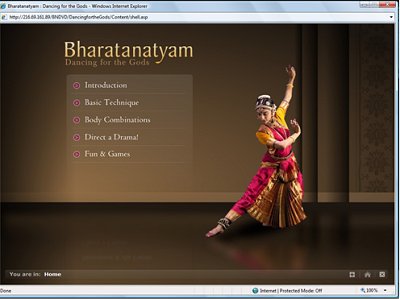
Homepage of Dancing for the Gods website As the success of www.narthaki.com has shown, the Internet offers an incredible opportunity to reach out to an almost infinite number of people. And, as of the last two years, we have sites like 'YouTube' and 'MySpace,' showing that it's a realistic goal to post high-quality video tutorials and demonstrations on-line for people to look at. This is a great opportunity for sharing and passing on information. As far as I know (and I've looked pretty hard!) Bharatanatyam is the first classical art form anywhere in the world to get a dedicated multimedia website. A first for India! What was the take off point for this project and how long have you been working on it? It began with a conversation I had with my husband Bruno Kavanagh at the Ellora Caves in Maharastra in early 2006. At the time we were living in Pune, near Bombay. My husband, who works in the field of computer-based education was setting up a subsidiary office for his New York based company Clearpoint Learning Systems. We'd taken a weekend trip to look at the cave temples, and we were wondering how we could help the lovely temple sculptures speak to the present day society, in a way that's relevant to the modern age. Based on his business experience, Bruno suggested that a good way to help make access and education more available is to provide on-line tools and interactivity for both students and teachers. And that's where we got the idea for Dancing for the Gods. After two years of extended research and development, we've finished the project...except, in a sense it will never be complete. This is the first phase of an on-going project that we look forward to adding to and developing even further over the times ahead. How is it meant to be used? Dancing for the Gods is an interactive program. It's not designed to be necessarily gone through 'in order.' You can dip into it for five minutes - to get a specific piece of information. Or sit down with it for an hour or more. If you really were crazy enough to go through it all in order…we estimate it would take at least 17 hours! There's over 10 hours of video alone - as well as animations, games, quizzes and so on. It's also designed for use as a teaching aid. These days, many teachers have access to a laptop and LCD projector. We are hoping that teachers will use the videos and interactive exercises in the classroom, projecting them on a screen (or just the wall!) and getting the class excited to participate. What is the basis of your teaching approach? Is it only based on the Kalakshetra style? What about the other styles in Bharatanatyam? Certainly, there are many other styles and methods of learning and teaching, which contributes to the richness of Bharatanatyam. We have based Dancing for the Gods on one of the best known basic texts, the Abhinaya Darpana. This covers the basics that are common to all styles - the way the body moves in space, the basic vocabulary of the form (gestures, walks, turns etc) and - very important - how to avoid injury. My training (with the Dhananjayans in Chennai) is in the Kalakshetra style. But it's important to remember that even this style is a relatively modern (20th century) evolution, drawing on many of the previous styles. There are some elements drawn from the ways that the devadasis themselves used to dance….but other expressions of the Kalakshetra style would be totally unrecognizable to the original devadasis! I make this point just to underline my belief, as a teacher and performer, that in 2008 we need to move beyond a perceived need to be confined in one specific style or another. The dancing - the quality of movement - should transcend these limitations. Would you say that the traditional teaching system and live teachers could be replaced? Dancing for the Gods is in no way to be seen as a substitute for the traditional teaching model. Teachers and Gurus are a vital part of a healthy system and will remain so forever. Apart from their skill as teachers, the teaching community (in all countries) is like huge 'warehouses' where huge amounts of cultural information is stored and can be accessed and passed on to younger generations. This is a vital function in the healthy life of the community. Dancing for the Gods is designed to be used as a supplement to live teaching. We hope it will help both students and teachers get access to basic information on the form, and help timid people who may, for whatever reason, be shy of attending a workshop or asking too many questions. This will help build confidence. Dancing for the Gods can also been seen as a 'leveller' by helping a very creative teacher be even more creative while helping teachers who are maybe a little more timid, with tools that can help open up his or her approach to the form, in terms of getting their students excited and engaged. A key aim of the program is to help the rasikas of the future take some strong steps along the road to being discerning connoisseurs of the art form. Who is the target audience for this program? We like to think that Dancing for the Gods has something for everyone - literally - who has any interest in Indian dance and culture. The course is designed to be used in many different ways. For example, someone who is not a student of dance, but who is interested in the spiritual and religious connections of Bharatanatyam will find videos and interactive sections that (for example) explore the significance and iconography of the famous Nataraja icon. 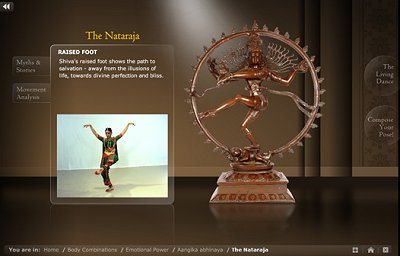
The spiritual and historical roots of the form are explored More serious students of the movement aspects (i.e. dance students) would want to look in more detail at the demonstration videos of the various mudras or, to take another example, the adavus and jatis. 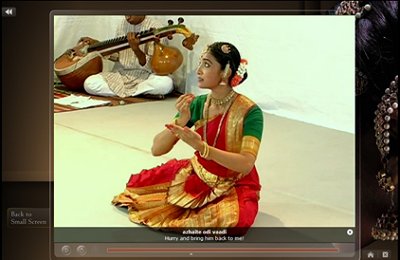 A full Varnam has subtitles, text and expert commentary provided Yet another person - maybe someone who wants to understand Bharatanatyam better so s/he can get more out of going to see live performances - might look at the Varnam performance video, which has subtitles, translations of the sung text, and an 'expert commentary' voice track that explains the Varnam as it plays. There is no barrier to someone looking at Dancing for the Gods at any age whatever. However, the exercises and lesson plans have been designed with an age range of 10-18 in mind. This is, of course, a key development stage in the life of a human being. The course aims to stimulate creative thinking through encouraging creativity, experiment and debate. 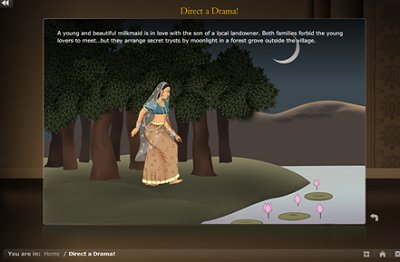 Interactive exercises stimulate imagination and creativity Dancing for the Gods is also designed to be used in the classroom. By simply plugging a laptop into an LCD projector, teachers can (guided by lesson plans that are provided) generate fun and interactive activities for groups of students. This is a key channel that will help to open up Bharatanatyam to non-Indian audiences. Often, the form is seen as quaint and exotic by non-Indians. But we want to help them get a better and deeper understanding that will help lead to an exciting cross-cultural dialogue. This will be achieved, amongst other things, by distributing the product to schools, libraries and museums. How is this program different from other videos, DVDs and VCDs on the market? The vast majority of existing learning material on Bharatanatyam takes the form of linear master classes and demonstrations. Some of these are excellent in terms of the quality of teaching and performance. However, Dancing for the Gods is fully interactive - putting the learner (you!) in charge of how you learn. It's not just a case of sitting back and watching. Whether you like it or not, you have to get involved! This is important because, these days, as a teacher, you can't just push information at kids and expect them to take it all in. You have to get them involved and speak their language. That's why we've come up with some totally new ideas for interactive features. For example, you can record your own movements on your webcam, then compare your performance to the 'master' demo. There is animation, and 3D graphical movement analysis. There's also a section called 'Fun & Games' which is just that - fun (but learning fun!). In another section, the 'Myths & Stories' of Hinduism and Indian spirituality are introduced, with fabulous photographs and animated characters (e.g. Garuda, the eagle vehicle of Vishnu). In the 'Direct a Drama' section, you even get to 'direct' a Bharatanatyam performance, choosing movements that a dancer will then use to act out a story. On the website (dancingforthegods.org) there are lesson plans for teachers to download and print, as well as a community and message board feature where we aim to build a vibrant community around the product, swapping and sharing thoughts and ideas - and sending energy and inspiration around the world! 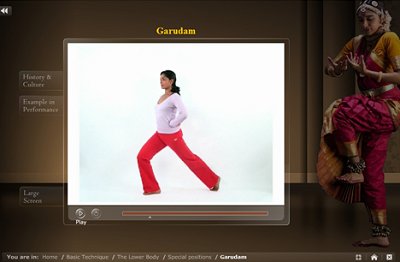 Screenshot showing a typical demonstration video Where was this created and designed? The project is entirely produced in India, using designers, illustrators, programmers and videographers from Chennai and Pune. We like the idea that an Indian company is pulling off a world-first: as far as we know - and we've looked pretty hard - this is the first time any classical art-form, Western or Eastern, has been presented in this way. I think this project represents a fantastic meeting-point between the ancient beauty of India and the vibrant 21st century nation. India is leading the way in the development and application of information technology, and it's only fitting that her classical arts should benefit from this leadership! Conceived, created and produced by Thresh: threshdance.org Dancing for the Gods can be accessed at: dancingforthegods.org Registration is free for a limited period of time. For current orders for the offline version (DVD), contact mail@dancingforthegods.org |